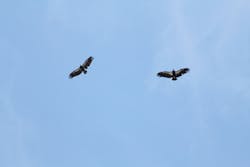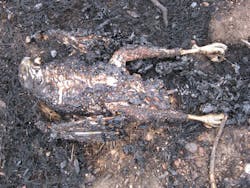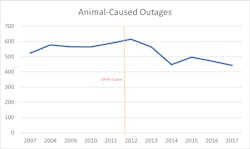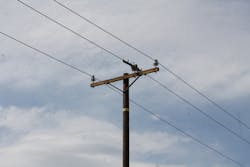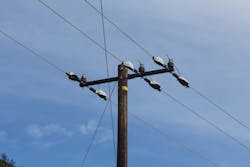Avian Protection & Wildfire Mitigation Go Hand in Hand
Original publication date: April 2021. Author Thuan Tran will be presenting at the 2023 T&D World Live Conference and Exhibition on California Wildfire Mitigation Plans and Strategies. For more information see the conference site.
Within and just outside Southern California Edison’s territory are two California condor release sites in the Hopper Mountain and Bitter Creek National Wildlife Refuges. California condors are listed as endangered by the U.S. Endangered Species Act of 1973. Electric utility infrastructure poses an electrocution hazard to California condors and many other protected bird species. As the California condor’s range expands and population grows, interactions with Southern California Edison (SCE) facilities are likely to increase.
While the California condor’s range is expanding so are the impacts of climate change and human development in the wildland-urban interface, resulting in more frequent and catastrophic wildfires. A quarter of SCE customers live in high-risk fire areas (HFRA). In response to this threat, SCE developed a wildfire mitigation plan (WMP) to protect public safety and reduce the risk of potential wildfire-causing ignitions. One potential source of ignition is wildlife contact with electrical infrastructure.
As part of its WMP, SCE has been evaluating circuit segments and areas for the installation of covered conductor, and it has installed several hundred miles already. Bringing structures up to current SCE standards and installing more covered conductor will reduce the potential for wildlife contact and other sources of ignition such as vegetation and weather. However, it will take time for the utility to complete this infrastructure hardening. In the interim, SCE has been performing enhanced overhead inspection (EOI) of structures in HFRA to identify and mitigate any imminent ignition risks, including those to avian protection.
Avian Protection Program
Wildlife contact on SCE’s system usually does not ignite a fire. However, when it does, the fire can range from burning a piece of equipment or pole all the way to thousands of acres, given the right conditions. For example, a bird could electrically bridge the distance from phase to ground or phase to phase. Depending on the contact location, the contact fault current magnitude and relay clearing time could generate incandescent particles that fall on dry grass to start an ignition. Another scenario is that the contact fault could exceed the current-carrying capability of a connection or splice, for example, which would cause a wire down and result in a fire igniting.
SCE first began efforts to protect endangered bird species in the 1980s, when awareness of electric utility infrastructure impacts on golden eagles increased. SCE’s focus was particularly on raptors, including eagles, hawks, falcons, owls and vultures. In addition to the impacts to birds that make contact with electric utility infrastructure, these incidents with power lines can result in outages, damaged utility equipment and wildfires. To address this issue, the Avian Power Line Interaction Committee (APLIC) and U.S. Fish and Wildlife Service (USFWS) released Avian Protection Plan Guidelines in 2005 to assist electric utilities in creating a plan to reduce negative avian interactions while improving electric utility system reliability.
One aspect of the guidelines is developing avian-safe construction design standards. Electrocutions are prevented by providing either sufficient separation of energized wires or energized wires and grounds, or covers suitable to the voltage to allow for incidental contact by birds, per guidance shared in APLIC’s 2006 book on “Suggested Practices for Avian Protection on Power Lines: The State of the Art.”
In 2012, SCE’s avian-safe distribution standards were updated considerably, using APLIC’s 2006 guidance to inform the changes. One major change was a move from only requiring avian protection covers in rural areas, where eagles and other raptors are more like to be found, to requiring them on all new and replaced equipment and structures throughout the entire service territory. In all actuality, most avian and other wildlife incidents occur in more urban areas, where the concentration of lines and equipment is higher. In addition, SCE expanded the areas that require further protections for eagles.
Improved Reliability
Because other wildlife incidents occur in the same manner as avian electrocutions, measures implemented to reduce avian electrocutions also can result in fewer incidents with other wildlife such as squirrels. Approximately 50% of SCE’s wildlife-caused outages are by birds, with the highest numbers of bird species being American crows, rock pigeons, common ravens and hawk species (primarily red-tailed hawks). The other 50% are caused mainly by mammals, with squirrels making up 42% of the utility’s wildlife-caused outages in 2018.
Although it is expected avian-safe construction design standards result in improved system reliability, there appears to be only one study published to date on this topic, focused on reducing squirrel-caused outages (Hamilton et al. 1989). On SCE’s system, the frequency of wildlife-caused outages has been trending down since 2014. In 2017, the frequency of distribution overhead wildlife-caused outages had declined significantly in comparison to the 10-year mean annual historical value. SCE analyzed outage data to investigate if the statistically significant decreased number of distribution overhead wildlife-caused outages was because of its updated distribution avian-safe construction standards.
SCE’s statistical analysis of wildlife-caused outages and the wildlife protection installed revealed that the decrease in wildlife-caused outages was significantly correlated to the increased number of pole replacements and new pole installations. Similarly, the decrease in wildlife-caused outages was significantly correlated to the quantity of material used for wildlife protection. This analysis suggests that implemented wildlife-caused outages prevention programs can improve system reliability.
Often, electric utilities implement avian-safe construction standards to reduce their risk of prosecution under the Migratory Bird Treaty Act and other laws that protect birds. APLIC often points out the benefits of improved reliability when an avian protection program is implemented, but it has often proven difficult for utility biologists to convince their company to modify construction standards without evidence. This analysis of SCE’s system shows, in a relatively short time frame, an electric utility can expect to see a reduction in outages caused by wildlife while reducing impacts to avian species, including after developing robust avian-safe construction standards.
Added Protection
In 2018, SCE further updated its distribution avian protection standards to include additional types of covers and require covers for all conductors. Today, the utility continues to implement its avian protection program, including building new and replaced infrastructure with avian-safe construction. SCE also retrofits older infrastructure with avian protection covers to address locations where electrocution incidents have occurred and proactively retrofits structures in areas where incidents are likely to occur.
In addition to updating its distribution standards, the utility updated its transmission overhead construction standards in 2020, focusing on voltages of 66 kV and 115 kV, to expand the clearances required in areas where golden eagles flock. These efforts dovetail nicely with the utility’s WMP efforts to reduce the potential for wildfire-causing ignitions.
California Condors
HFRA strongly overlap with where California condors appear in SCE’s service territory and their USFWS-designated critical habitat. SCE also obtained geographic information system data of condors outfitted with telemetry units from the U.S. Geological Survey and analyzed their movements to create a mapped area where they are most likely to interact with the utility’s facilities. This area also almost completely overlaps with HFRA.
Condors are large-bodied, long-winged and slow-flying birds, making them more susceptible to electrocutions and collisions with power lines. Their long wings can easily bridge the space between conductors, and their slow flight makes it harder for them to avoid colliding with power lines, particularly under low-light, rainy or foggy conditions. One of the reasons for the installation of covered conductor in HFRA is to prevent avian contact-related fault and ignition. In turn, this prevents collision-based electrocutions of condors, by making contact midspan, as well as electrocutions occurring from perching on a pole. Some condor higher-risk areas have been addressed already by SCE, but the installation of thousands of miles of covered conductor over the next couple of years as part of the utility’s WMP will accelerate this process, helping to preserve the California condor.
Available Resources
The issue of wildfires is not unique to SCE alone but rather faced by many electric utilities. This topic is important to electric utilities throughout the western U.S. and other parts of the world experiencing increases in the incidence and severity of wildfires. Although utilities have a lot to take into consideration when attempting to proactively address this issue, the interaction of power lines and wildlife should be part of any strong wildfire mitigation efforts.
Much is known already and many options exist to address wildlife interactions with power lines. Electric utilities can seek guidance — in the form of books, papers, workshops and other resources — by APLIC to learn more about reducing avian incidents. By becoming a member of APLIC, an electric utility also gains access to more than 30 years of efforts to address these issues and the combined knowledge and experience of the more than 70 electric utility APLIC members, including SCE.
A well-implemented avian protection program can improve system reliability while also protecting an important resource in the avian species for many generations to come.
Kara Donohue is avian program manager for Southern California Edison (SCE). She has been with SCE since 2007, working to reduce the utility’s impacts on protected avian species. Donohue served as chair of the Avian Power Line Interaction Committee (APLIC). She received her bachelor’s degree in zoology from the University of Michigan and master’s degree in raptor biology from Boise State University.
Hogan Fenster is an environmental specialist on the SCE environmental clearance team. He has worked at the utility since 2018, when he began as a summer intern exploring the intersects of California condor protection and wildfire mitigation using covered conductor. Fenster received his bachelor’s degree in 2019 from UCLA, where he studied environmental science and conservation biology, and now works to protect various diverse resources across SCE’s territory.
Thuan Tran is principal manager for T&D apparatus and linear asset and engineering strategies at SCE. He has been instrumental in developing the standards for wildfire mitigation to combat the wildfire risks in Southern California. Tran received his BSEE degree from the University of California, Irvine, master’s degree in engineering with an emphasis in electrical power from the University of Idaho and MBA degree from the University of Laverne, California. He is a registered electrical engineer in the state of California.
About the Author
Kara Donohue
Kara Donohue ([email protected]) is avian program manager for Southern California Edison (SCE). She has been with SCE since 2007, working to reduce the utility’s impacts on protected avian species. Donohue served as chair of the Avian Power Line Interaction Committee (APLIC). She received her bachelor’s degree in zoology from the University of Michigan and master’s degree in raptor biology from Boise State University.
Hogan Fenster
Hogan Fenster ([email protected]) is an environmental specialist on the SCE environmental clearance team. He has worked at the utility since 2018, when he began as a summer intern exploring the intersects of California condor protection and wildfire mitigation using covered conductor. Fenster received his bachelor’s degree in 2019 from UCLA, where he studied environmental science and conservation biology, and now works to protect various diverse resources across SCE’s territory.
Thuan Tran
Principal Manager, T/D Apparatus & Linear Asset and Engineering Strategies
Thuan Tran is the Principal Manager for T/D Apparatus & Linear Asset and Engineering Strategies at Southern California Edison. He has been instrumental in developing the wildfire mitigation plan to combat the wildfire risks in California. He has held various positions in Distribution, Substation and System Protection Engineering groups. He was instrumental in the development of the distribution automation system for control and monitor pole-mounted switches, capacitors and automatic reclosers in the early 1990’s. As an engineer, Thuan successfully developed the specifications and commissioned a number of major projects, including Static VAR Compensators, 500 kV series capacitors, 500-220 kV Gas Insulated Switchgear (GIS).Thuan received his bachelor’s degree in electrical engineering the from the University of California, Irvine, Master’s degree in Engineering with the emphasis in Electrical Power from the University of Idaho and MBA from University of Laverne, California. He's a registered electrical engineer at the state of California. Thuan enjoys playing sports and travel.
